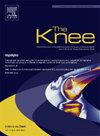Management of bone loss in revision total knee arthroplasty with tantalum cones: Primary aseptic revision versus multiple revisions
IF 2
4区 医学
Q3 ORTHOPEDICS
引用次数: 0
Abstract
Background
The increasing number of revisions following total knee arthroplasty (TKA) has led to the appearance of new challenges, including the management of bone defects. The use of porous tantalum cones is one of the options to address this bone loss.
Purpose
We carried out a retrospective study to compare the medium-term outcomes of single and multiple TKA revisions in the context of massive bone defects using tantalum cones. We analyzed: (1) the survival of the revision implants, (2) osseointegration of the cone, (3) the clinical and functional outcomes, (4) complications.
Methods
Between July 2011 and May 2019, 79 metaphyseal reconstructions (MRs) were performed in 58 patients (mean age 68 ± 11 (41–89)) who received tantalum cones during the procedure. Revisions for infection were excluded. The massive bone defects were classified as Anderson Orthopaedic Research Institute types 2B/3. The cone had to be removed in 12 patients (16 MRs). Implant survival free of all-cause revision and cone survival free of aseptic loosening were calculated. Osseointegration of the cones was determined on radiographs. A subset of patients (n = 46) underwent a clinical assessment including the OKS, KSS, KOOS, satisfaction level and knee flexion. All of the patients (n = 58) underwent a radiological assessment. Complications were documented during the follow up period.
Results
The mean follow up was 73.1 months ± 29.8 (12–143). In all, 91 cones (48 at the femur and 43 in the tibia) had been implanted during 79 MR procedures: 40 in the primary revision group (R-primary) and 39 in the multiple revision group (R-multiple). Survivorship of the implant free of all-cause revision at 6 years was better in the R-primary group, 97.5 % (95 %CI: 93 % to 100 %) than in the R-multiple group, 70.5 % (95 %CI: 57 % to 87 %) (P < 0.01). Survivorship of the cone free of aseptic loosening at 6 years was comparable between the two groups: 100 % (95 %CI 100 % to 100 %) for R-primary and 96.8 % (95 %CI 91 % to 100 %) for R-multiple (P = 0.26). At the final assessment, 10 of 91 cones had no bone ingrowth; all of them were in the R-multiple group (P = 0.012). The functional outcomes were better in the R-primary group. The mean OKS was 31.5 ± 8.7 (16–45) vs. 25.7 ± 9.1 (9–41) in the R-multiple group (P = 0.014). The mean KSS global was 146.2 ± 32.3 (69–197) vs. 136.8 ± 20.9 (98–182) in the R-multiple group (P = 0.082). The KOOS global was 61.3 ± 17 (26–84) vs. 48.3 ± 15.7 (18–79) in the R-multiple group (P < 0.01). In the R-primary group, 78 % of patients (22/28) were satisfied or very satisfied with the outcome vs. 61 % (11/18) in the R-multiple group (P = 0.25). The mean knee flexion at the final assessment was 102.7 ± 24.2 (20–125) in the R-primary group vs. 98.3 ± 16.5 (70–120) in the R-multiple group (P = 0.36). A re-revision was needed in 16 of the 79 MRs (20 %). The most common cause of failure was a periprosthetic infection in almost half of these cases (eight of 16). Only one re-revision was needed in the R-primary group, while 15 were needed in the R-multiple group (P < 0.001).
Conclusions
MR using porous tantalum biomaterials is a viable technique for managing massive bone defects during TKA revision. Multiple revisions were associated with worse implant survivorship and worse functional outcomes than primary (or first) revisions, along with having a higher likelihood of infection-related complications. The survivorship of the cones free of aseptic loosening was comparable between primary and repeat revisions. Loosening was more frequent on the femoral side than the tibial side.
钽锥全膝关节置换术翻修中骨丢失的处理:初次无菌翻修与多次翻修
背景:全膝关节置换术(TKA)后越来越多的翻修导致了新的挑战的出现,包括骨缺损的处理。使用多孔钽锥是解决这种骨质流失的选择之一。目的:我们进行了一项回顾性研究,比较在大量骨缺损中使用钽锥进行单次和多次TKA修复的中期结果。我们分析:(1)修复种植体的存活,(2)椎体的骨整合,(3)临床和功能结果,(4)并发症。方法在2011年7月至2019年5月期间,对58例(平均年龄68±11(41-89))接受钽锥治疗的患者进行79例干骺端重建(MRs)。不包括对感染的修订。大量骨缺损被安德森骨科研究所分类为2B/3型。有12例患者(16例MRs)不得不摘除锥体。计算无全因翻修的种植体存活时间和无无菌松动的锥体存活时间。通过x线片确定椎体的骨整合。一部分患者(n = 46)接受了临床评估,包括OKS、KSS、KOOS、满意度和膝关节屈曲。所有患者(n = 58)均接受放射学评估。在随访期间记录了并发症。结果平均随访时间为73.1±29.8(12-143)个月。总共有91个锥体(48个在股骨,43个在胫骨)在79次MR手术中被植入:40个在一次翻修组(R-primary), 39个在多次翻修组(R-multiple)。r -原发性组6年无全因翻修的种植体存活率为97.5% (95% CI: 93%至100%),优于r -多重组的70.5% (95% CI: 57%至87%)(P <;0.01)。两组6年无无菌性松动椎体的生存率相当:r -原发性组为100% (95% CI为100%至100%),r -多发性组为96.8% (95% CI为91%至100%)(P = 0.26)。在最后的评估中,91个球果中有10个没有骨长入;均为r多组(P = 0.012)。R-primary组功能预后较好。r组的平均OKS为31.5±8.7(16-45)比25.7±9.1 (9-41)(P = 0.014)。r组KSS评分为146.2±32.3 (69-197),r组为136.8±20.9(98-182),差异有统计学意义(P = 0.082)。r -多重组的KOOS评分为61.3±17(26-84)比48.3±15.7 (18-79)(P <;0.01)。在R-primary组中,78%的患者(22/28)对结果满意或非常满意,而R-multiple组为61% (11/18)(P = 0.25)。最终评估时R-primary组的平均膝关节屈曲度为102.7±24.2 (20-125),R-multiple组为98.3±16.5 (70-120)(P = 0.36)。79例MRs中有16例(20%)需要再次翻修。最常见的失败原因是假体周围感染,几乎占这些病例的一半(16例中的8例)。r -原发性组仅需1次再翻修,而r -多发性组需15次(P <;0.001)。结论利用多孔钽生物材料进行smr是修复TKA修复中大量骨缺损的可行技术。与初次(或首次)修复相比,多次修复与更差的种植体成活率和更差的功能结果相关,并且有更高的感染相关并发症的可能性。无无菌性松动的锥体的存活率在初次和重复翻修之间是相当的。股骨侧松动比胫骨侧更常见。
本文章由计算机程序翻译,如有差异,请以英文原文为准。
求助全文
约1分钟内获得全文
求助全文
来源期刊

Knee
医学-外科
CiteScore
3.80
自引率
5.30%
发文量
171
审稿时长
6 months
期刊介绍:
The Knee is an international journal publishing studies on the clinical treatment and fundamental biomechanical characteristics of this joint. The aim of the journal is to provide a vehicle relevant to surgeons, biomedical engineers, imaging specialists, materials scientists, rehabilitation personnel and all those with an interest in the knee.
The topics covered include, but are not limited to:
• Anatomy, physiology, morphology and biochemistry;
• Biomechanical studies;
• Advances in the development of prosthetic, orthotic and augmentation devices;
• Imaging and diagnostic techniques;
• Pathology;
• Trauma;
• Surgery;
• Rehabilitation.
 求助内容:
求助内容: 应助结果提醒方式:
应助结果提醒方式:


